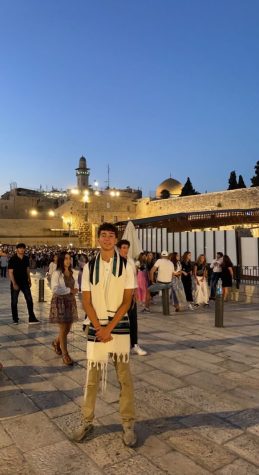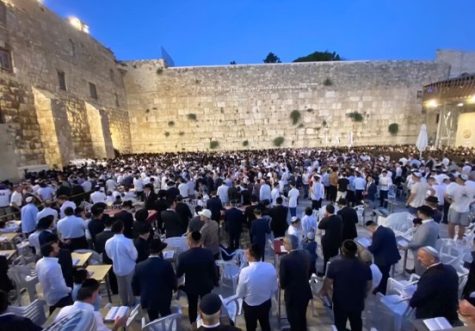In the center of the Jewish world, the Western Wall connects rather than divides us
Ohr Chadash Teen Page writer Benjamin Kruger (above) writes about his recent visit to the Western Wall in Jerusalem.
Published November 22, 2022
There is something poetic about the wall. It exists as a border; a formidable obstacle to separate components. But as is often true about poetic instruments, this wall had another meaning. The dichotomy of the wall: the symbolic value of both separation and connection.
I rummaged through my bag to find my tallis. The dark blue cloth caught my eye and I grabbed it. As I draped the sacred cloth across my shoulders, I stopped for a moment and recalled using that same movement three years before. It was a much shorter and smaller Benjamin who stood on the bimah of his synagogue, anxiously holding his tallis in anticipation for his bar mitzvah. Despite his nerves, young Benjamin found comfort in his tallis.
Now, I stood in the holy land of Israel. In the Old City of Jerusalem — the absolute center of the Jewish world — standing in front of the Wailing Wall: the most sacred spot for Jews on the planet. And I knew with absolute conviction that the admiration and respect that I held for my tallis on the day of my bar mitzvah had not changed to this day.
ADVERTISEMENT
With pride I strolled up to the wall, bent my knees and rested my head on the ivy-covered rock. When I closed my eyes to recite the shemah, my connection to Judaism had never felt stronger.
An elderly man wrapped in tefillin stood by the wall. He held his hand out in invitation to me. He was a rabbi and asked if I wanted him to wrap my tefillin. I didn’t know the man. He looked different than me and spoke with a strange accent. But for some inexplicable reason I looked him in the eye and said, “Yes of course, thank you sir.”

I still remember how my voice shook when I said this: overwhelmed with the kindness, overwhelmed with the spiritual significance.
ADVERTISEMENT
He looked at me with eyes that twinkled, and a splash of humor across his face. He said to me with a smile, “Don’t call me sir. Call me brother.”
Jewish identity has many names. Among many others it’s been called a race, an ethnicity, a nationality and a religion.

During the Holocaust the Nazi party considered Judaism to be a race. They used a person’s heritage, physical features and blood to determine if they were a Jew. This form of identification was used to systematically slaughter the Jewish people and is certainly not compatible with the way that I identify as Jewish.
Contrary to a popular and commonly taught idea, Judaism is not entirely confined to being a religion. There is no specific belief that one must hold, nor is there a tradition that one must abide by to be considered Jewish. A Jew who worships G-d multiple times a day, keeps kosher and wears a kippah all day is no more Jewish than the Jew who eats cheeseburgers and believes in no G-d at all.
If we are an ethnicity, a distinction that has so often been used to persecute Jews, then conversion to Judaism would not be possible so this is incorrect.
With regards to the state of Israel, Judaism is often conflated with Zionism. Regardless of the Jews beliefs or political affiliation, they are immediately associated with the Jewish state. Jews, both inside and outside of Israel approach support of Israel differently, to assume we all see it the same way is an incorrect oversimplification.
The Jewish identity has been treated many different ways. It’s been kicked and beaten, misunderstood and villainized. It has been tortured and persecuted, feared and distrusted. And at every moment of its existence, every joyous dance, every thoughtful prayer, and every song of worship, the endless threat of antisemitism lurks nearby. The Jewish identity has been marked and certainly bruised. But it’s never been broken.
No wall can divide what is true about Judaism. No obstacle can stand between the Jewish people, nor can any barrier protect the Jews from external hatred. But at this moment the dichotomy of the wall becomes significant.
As I stood with my forehead pressed up against the aged holy stone, I knew Hashtiyya — the kissing of the heavens and the Earth. The synthesis of faith and knowledge. The blend of spirituality and reality.
And thus, the truth of Judaism becomes clear — connection. And for this truth, no social label can define or encompass Judaism. No, the rabbi was right.
The Jewish people are a family.















